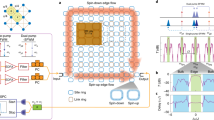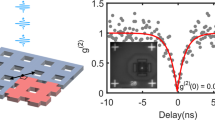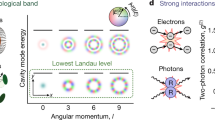Abstract
Quantum light is characterized by distinctive statistical distributions that are possible only because of quantum mechanical effects. For example, single photons and correlated photon pairs exhibit photon number distributions with variance lower than classically allowed limits. This enables high-fidelity transmission of quantum information and sensing with lower noise than possible with classical light sources1,2. Most quantum light sources rely on spontaneous parametric processes such as down-conversion and four-wave mixing2. These processes are mediated by vacuum fluctuations of the electromagnetic field. Therefore, by manipulating the electromagnetic mode structure, for example with dispersion-engineered nanophotonic systems, the spectrum of generated photons can be controlled3,4,5,6,7. However, disorder, which is ubiquitous in nanophotonic fabrication, causes device-to-device spectral variations8,9,10,11. Here we realize topologically robust electromagnetic modes and use their vacuum fluctuations to create a quantum light source in which the spectrum of generated photons is much less affected by fabrication-induced disorder. Specifically, we use the topological edge states realized in a two-dimensional array of ring resonators to generate correlated photon pairs by spontaneous four-wave mixing and show that they outperform their topologically trivial one-dimensional counterparts in terms of spectral robustness. We demonstrate the non-classical nature of the generated light and the realization of a robust source of heralded single photons by measuring the conditional antibunching of photons, that is, the reduced likelihood of photons arriving together compared to thermal or laser light. Such topological effects, which are unique to bosonic systems, could pave the way for the development of robust quantum photonic devices.
This is a preview of subscription content, access via your institution
Access options
Access Nature and 54 other Nature Portfolio journals
Get Nature+, our best-value online-access subscription
$29.99 / 30 days
cancel any time
Subscribe to this journal
Receive 51 print issues and online access
$199.00 per year
only $3.90 per issue
Buy this article
- Purchase on Springer Link
- Instant access to full article PDF
Prices may be subject to local taxes which are calculated during checkout





Similar content being viewed by others
Data availability
The data that support the findings of this study are available from the corresponding author on reasonable request.
References
Shields, A. J. Semiconductor quantum light sources. Nat. Photon. 1, 215–223 (2007).
Eisaman, M. D., Fan, J., Migdall, A. & Polyakov, S. V. Single-photon sources and detectors. Rev. Sci. Instrum. 82, 071101 (2011).
Sharping, J. E. et al. Generation of correlated photons in nanoscale silicon waveguides. Opt. Express 14, 12388–12393 (2006).
Clemmen, S. et al. Continuous wave photon pair generation in silicon-on-insulator waveguides and ring resonators. Opt. Express 17, 16558–16570 (2009).
Förtsch, M. et al. A versatile source of single photons for quantum information processing. Nat. Commun. 4, 1818 (2013).
Davanço, M. et al. Telecommunications-band heralded single photons from a silicon nanophotonic chip. Appl. Phys. Lett. 100, 261104 (2012).
Kumar, R., Ong, J. R., Savanier, M. & Mookherjea, S. Controlling the spectrum of photons generated on a silicon nanophotonic chip. Nat. Commun. 5, 5489 (2014).
Topolancik, J., Ilic, B. & Vollmer, F. Experimental observation of strong photon localization in disordered photonic crystal waveguides. Phys. Rev. Lett. 99, 253901 (2007).
Mookherjea, S., Park, J. S., Yang, S.-H. & Bandaru, P. R. Localization in silicon nanophotonic slow-light waveguides. Nat. Photon. 2, 90–93 (2008).
Sapienza, L. et al. Cavity quantum electrodynamics with anderson-localized modes. Science 327, 1352–1355 (2010).
Spring, J. B. et al. Chip-based array of near-identical, pure, heralded single-photon sources. Optica 4, 90–96 (2017).
Morichetti, F. et al. Travelling-wave resonant four-wave mixing breaks the limits of cavity-enhanced all-optical wavelength conversion. Nat. Commun. 2, 296 (2011).
Lu, L., Joannopoulos, J. D. & Soljačić, M. Topological photonics. Nat. Photon. 8, 821–829 (2014).
Wang, Z., Chong, Y., Joannopoulos, J. D. & Soljačić, M. Observation of unidirectional backscattering-immune topological electromagnetic states. Nature 461, 772–775 (2009).
Hafezi, M., Demler, E. A., Lukin, M. D. & Taylor, J. M. Robust optical delay lines with topological protection. Nat. Phys. 7, 907–912 (2011).
Hafezi, M., Mittal, S., Fan, J., Migdall, A. & Taylor, J. M. Imaging topological edge states in silicon photonics. Nat. Photon. 7, 1001–1005 (2013).
Rechtsman, M. C. et al. Photonic Floquet topological insulators. Nature 496, 196–200 (2013).
Chen, W.-J. et al. Experimental realization of photonic topological insulator in a uniaxial metacrystal waveguide. Nat. Commun. 5, 5782 (2014).
Cheng, X. et al. Robust reconfigurable electromagnetic pathways within a photonic topological insulator. Nat. Mater. 15, 542–548 (2016).
Kraus, Y., Lahini, Y., Ringel, Z., Verbin, M. & Zilberberg, O. Topological states and adiabatic pumping in quasicrystals. Phys. Rev. Lett. 109, 106402 (2012).
Hafezi, M. Measuring topological invariants in photonic systems. Phys. Rev. Lett. 112, 210405 (2014).
Mittal, S., Ganeshan, S., Fan, J., Vaezi, A. & Hafezi, M. Measurement of topological invariants in a 2D photonic system. Nat. Photon. 10, 180–183 (2016).
Mittal, S. et al. Topologically robust transport of photons in a synthetic gauge field. Phys. Rev. Lett. 113, 087403 (2014).
St-Jean, P. et al. Lasing in topological edge states of a one-dimensional lattice. Nat. Photon. 11, 651–656 (2017).
Bahari, B. et al. Nonreciprocal lasing in topological cavities of arbitrary geometries. Science 358, 636–640 (2017).
Peano, V., Houde, M., Marquardt, F. & Clerk, A. A. Topological quantum fluctuations and traveling wave amplifiers. Phys. Rev. X 6, 041026 (2016).
Shi, T., Kimble, H. J. & Cirac, J. I. Topological phenomena in classical optical networks. Proc. Natl Acad. Sci. USA 114, E8967–E8976 (2017).
Chen, J., Levine, Z. H., Fan, J. & Migdall, A. L. Frequency-bin entangled comb of photon pairs from a silicon-on-insulator micro-resonator. Opt. Express 19, 1470–1483 (2011).
Ong, J. R. & Mookherjea, S. Quantum light generation on a silicon chip using waveguides and resonators. Opt. Express 21, 5171–5181 (2013).
Yariv, A., Xu, Y., Lee, R. K. & Scherer, A. Coupled-resonator optical waveguide: a proposal and analysis. Opt. Lett. 24, 711–713 (1999).
Bauters, J. F. et al. Ultra-low-loss high-aspect-ratio Si3N4 waveguides. Opt. Express 19, 3163–3174 (2011).
Moss, D. J., Morandotti, R., Gaeta, A. L. & Lipson, M. New CMOS-compatible platforms based on silicon nitride and hydex for nonlinear optics. Nat. Photon. 7, 597–607 (2013).
Acknowledgements
This research was supported by AFOSR-MURI FA9550-14-1-0267, YIP-ONR, Sloan Foundation and the Physics Frontier Center at the Joint Quantum Institute. We thank V. V. Orre for help with the experimental set-up, A. Karasahin for help with the SEM, T. Huber and D. Englund for discussions and Q. Quraishi for providing the nanowire detectors.
Reviewer information
Nature thanks V. Peano and the other anonymous reviewer(s) for their contribution to the peer review of this work.
Author information
Authors and Affiliations
Contributions
S.M. and M.H. conceived the idea. S.M. performed the numerical simulations and the experimental measurements. E.A.G. contributed to source characterization. M.H. supervised the project. All authors contributed to analysing the data and writing the manuscript.
Corresponding author
Ethics declarations
Competing interests
The authors declare no competing interests.
Additional information
Publisher’s note: Springer Nature remains neutral with regard to jurisdictional claims in published maps and institutional affiliations.
Extended data figures and tables
Extended Data Fig. 1 Spectral correlations.
a–c, Measured Γ(ωs, ωp) on three different 2D devices; d–g, measured Γ(ωs, ωp) on four different 1D devices, in addition to those presented in Fig. 3. Clockwise edge bands for the 2D devices and mid-band for the 1D devices are highlighted.
Extended Data Fig. 2 Transmission spectra of 2D and 1D devices.
a, b, Measured transmission spectra for (a) different 2D and (b) different 1D devices. The shaded regions highlight the edge and the bulk bands for the 2D system and the mid-band for the 1D system. For the 2D devices, the clockwise and the anticlockwise edge bands show reduced variations in the transmission compared with that in the bulk band. These spectra have been shifted along the frequency axis to superpose them, using an algorithm based on transmission and delay measurements, as detailed in ref. 23.
Extended Data Fig. 3 Transmission spectrum of a 2D device across three FSRs.
Measured transmission spectrum in the pump, signal and idler FSRs, corresponding to Fig. 2. ∆ν is the frequency relative to the longitudinal mode resonance, and Ω is the FSR. The shape of the transmission spectrum in these FSRs is almost identical. The small variation in the overall transmission across bands is mainly because of the frequency response of the grating couplers.
Extended Data Fig. 4 Joint spectral intensity.
a, The measured Γ(ωs, ωp) (see Fig. 2): that is, the intensity of generated signal photons at frequency ωs as a function of pump frequency, ωp. Each point on this plot represents a particular ωs and ωp. Using energy conservation, we can calculate the corresponding idler frequency at each point as ωi = 2ωp − ωs. Therefore, we can easily rescale the y axis of the plot and calculate the joint-spectral intensity (JSI; see refs 11,29) between the signal and idler frequencies, as shown in b. Note that this rescaling works only for a continuous-wave pump because for a pulsed pump source, the above energy conservation relation holds only up to the spectral bandwidth of the pump, signal and idler photons. Also, this measurement inherently assumes that the generated signal and idler photons are correlated. Using CAR and direct measurements of the signal and idler spectra (in Figs. 2, 3), we verified that the signal and idler photons are indeed correlated. The main advantage of such a spectral correlation measurement between the pump and the signal (or idler) photons is that it is fast and, for a continuous-wave pump, is equivalent to the JSI measurement.
Rights and permissions
About this article
Cite this article
Mittal, S., Goldschmidt, E.A. & Hafezi, M. A topological source of quantum light. Nature 561, 502–506 (2018). https://doi.org/10.1038/s41586-018-0478-3
Received:
Accepted:
Published:
Issue Date:
DOI: https://doi.org/10.1038/s41586-018-0478-3
Keywords
This article is cited by
-
Topological single-photon emission from quantum emitter chains
npj Quantum Information (2024)
-
Discrete nonlinear topological photonics
Nature Physics (2024)
-
Non-local skyrmions as topologically resilient quantum entangled states of light
Nature Photonics (2024)
-
Programmable integrated photonics for topological Hamiltonians
Nature Communications (2024)
-
Non-Hermitian topological phase transitions controlled by nonlinearity
Nature Physics (2024)
Comments
By submitting a comment you agree to abide by our Terms and Community Guidelines. If you find something abusive or that does not comply with our terms or guidelines please flag it as inappropriate.



